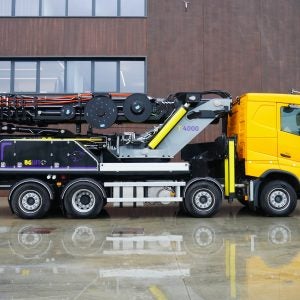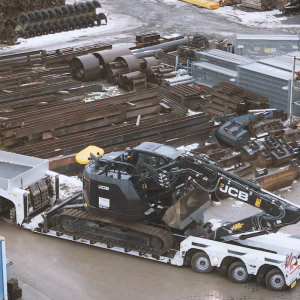In the past, large crawler cranes have only been available as imports. In response, over the last few years Chinese manufacturers have rolled out larger and larger crawlers. In a press release, Shanghai Sany said that its business goal is “fully replacing the import of crawler cranes and greatly open up to the international market.”
In superlift configuration, the crane can lift 900t at 7m radius (and out to 12m), and 800t to 17m. In this set-up, the crane has 42m superlift mast and 450t counterweight hanging from a tray, with 250t counterweight carried on the rear of the crane and 80t on the carbody.
In luffing-jib configuration with superlift, the crane has a maximum system length of 96m (315ft) main boom + 96m jib. It can lift the hook to 188m high. In a similar configuration with 42m boom, the crane can lift 28t to 112m radius.
Maximum main boom length is 120m (393ft) with superlift, 90m without. The crane can be set up with a total of 16 boom configurations.
The crane is powered by a Cummins QSK23 diesel engine that generates 597kW at 2,100rpm and a maximum torque of 3,308N at 1,400rpm. The crane weighs 740t in total, although it is unclear how much boom is included in that figure.
The main hydraulic system of the SCC9000, and smaller sibling the SCC6300, are both a closed-loop architecture ‘with independent intellectual property,’ the company says. The Rexroth or Kawasaki-made systems have an improved response to load effects compared with open-loop designs. The cranes have an independently developed control, fault self-diagnosis and alarm software with LMI and black box. The crane has two working modes, operation and installation mode, which overrides some safety systems. The crane also has a winch surveillance device and lightning protection system.
Main boom and jib sections can be inserted into each other during transportation. The maximum transport weight of a component is 52.5t. Maximum transport dimensions are 15m long (590in) by 3.58m (141in) wide by 3.24m (134in) high.
A remote fault diagnosis system with GPS satellite positioning, equipment status and statistics functions is available as an option.
The crane is scheduled to be launched formally at a ceremony next week. The company says that it has started development of a 1,600t crawler crane in cooperation with an unnamed partner.
Sany says that its 50t and 80t crawlers have passed Russian GOST certification, North American certification and CE marking. In addition, its 100t, 150t, 200t, 250t and 320t models have passed North American certification and CE marking. Its 400t product has also been CE marked. It also says that all its crawlers meet Australian and Korean standards.
The company claims a product series of a total of 22 designs from 50t to 3,000t capacity, including two duty-cycle machines (SCC650HD and SCC1000HD), although it only gives specifications for a total of 10 models. There are at least four designs apparently not yet built: 1,000t-capacity SCC10000, 1,280t-capacity SCC12800, 1,600t-capacity SCC16000 and 3,000t-capacity SCC30000.
The company said that its research and development department has more than 300 people in five divisions: crawler crane research, hydraulics, self-control, process and a technology centre. The crawler crane research institute has product project teams, engineering analysis lab, industrial design lab, a basic research team and others, and can design cranes up to 3,200t capacity.
Cranes Today understands that the crane will be available in June 2008.






